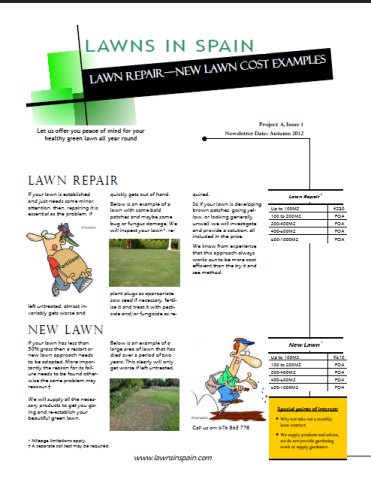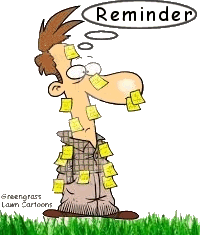Lawn Repair
| Lawn
repair with our warm season grasses is almost unnecessary as
our grasses creep and therefore repair themselves. But if
you do have problems with your lawn, then it is not always
necessary to plant a new lawn, you might be able to repair it. A lawn repair can be by far the most cost effective solution. It not only gives
you a chance to have a new lawn for the minimum cost, but
also, if you are repairing an old lawn in the Autumn, you have
the opportunity to plant a cool season grass that will provide
you with a green lawn ready for when your warm season grass
starts to grow again in the Spring. However before any lawn repair is undertaken, some
planning is required.
For an instant repair to an existing lawn see our Instant Lawn Repair Patches. |

click on image to view details |
Planning
If it's just the quality of your lawn is not good, then go to the next section. However if your lawn is made up a different types of grass then the decision to improve and repair the lawn will depend on which grass type in your lawn you wish to encourage. In general, the more vigorous and drought resistant (warm season) grasses will be the survivors in your lawn. Overseeding or re-sowing will not get rid of them. However overseeding or plugging with more aggressive warm season grasses can repair a lawn and the new grass will soon become the dominant species in your repaired lawn. If you are not happy with this approach, then a total renovation should be undertaken to eradicate the unwanted grasses. If you at all uncertain as to the reason for your lawn failure, we suggest a lawn soil test and maybe a visit.
Types of Lawn Repair:
There are different types of lawn repair or renovation that you can use to help with your lawn repair and/or replacement, but before attempting a lawn repair, a soil test is advisable. It may uncover a more underlying reason for your failed lawn.
|
Fact: The amount of lawn repair or renovation you require, will depend on the condition of your lawn and your needs. If more than 50% of your lawn is weeds, brown patches or unwanted grass then we would suggest a total renovation. |
|
 Quick
Tips (Start Again)
Grass forms 50%
or less of your old lawn. Basically you have more you don't want
than is worth keeping. Quick
Tips (Start Again)
Grass forms 50%
or less of your old lawn. Basically you have more you don't want
than is worth keeping.This approach purges all unwanted weeds and grasses and provides you with a clean slate for a new lawn. 1) Fertilise with Lawns in Spain Fertiliser. This is strong and
does the job. (2 Kilos per
100M2) Water in and water again in 3 days. 6) Sow seed or plant plugs or both. |
 Quick
Tip (Repair what you have) Grass
forms 50%
or more of your old lawn. Basically your lawn is poor but can be
improved upon. Not quite as thorough but acceptable. Quick
Tip (Repair what you have) Grass
forms 50%
or more of your old lawn. Basically your lawn is poor but can be
improved upon. Not quite as thorough but acceptable.
This approach avoids the time when you are looking at brown soil. 1) Feed with Lawns in Spain Strong Summer Mix Fertiliser. (2 Kilos per 100M2). Water the lawn. 2) Water the lawn again in 3 days. 3) After 7 days, re-apply more fertiliser (2 Kilos per 100M2) and water the lawn. 4) Water the lawn again in 3 days. 5) Sow one of our "Wintergreen" lawn seed. This will reinforce your existing lawn grass, and give you new grass in 7 - 10 days. (Select from seed page) 6) For drought resistance for the Summer months, plant warm
season grass plugs. (select from our Grass
Gallery page) |
Below is a description of different processes, and what you need to do to make your lawn repair or renovation successful.
Soil Testing, Aerating, De-thatching, Weeding, Feeding, Dead-Spot or brown patch replacement, Leveling bumps and depressions, Grass replacement, Reseeding, Plugging, Total renovation.
1) Lawn Repair - Soil Testing.
Knowing whether your soil is alkaline or acidic by performing a soil test is important, because certain types of grass grow better in slightly acidic soils and certain types tolerate alkaline soils. Knowing what type of soil you have will not only help in choosing the right type of grass, but also help in deciding what type of soil remedial work is necessary.
2) Lawn Repair - Aerating.
This will probably be necessary if you have clay soil and it has become compacted by heavy traffic. Aeration is an excellent first stage lawn repair. There are many tools for performing lawn aeration, but a garden fork dug into the soil to about 6 inches will do well.
3) Lawn Repair - De-thatching
Thatch is a layer of old grass, roots, clippings, and debris that settle on the ground over time. Removing thatch and dead organic matter from the surface of your lawn is a good first step in lawn repair. Thatch buildup is commonly found in old lawns where grass has grown tall, mulch is frequently left, and lawns that have never been aerated. If your lawn seems unusually slow in responding to waterings, fertilizing, and reseeding, then de-thatching may be needed.
There are special de-thatching tools that you can buy, but a garden rake or wire rake will do the job. Rake the ground aggressively down to soil level. Clear the rubbish from the rake and burn or compost.
4) Lawn Repair - Weeding
Use a selective (broad leaf) weed killer. There are different types of weed killer for different types of weeds and different types of grass. We have recommended weed killers that have been tested for use on our grass types. See our Lawns in Spain lawn care products page for details.
5) Lawn Repair - Feeding
The choice of lawn fertilizer will depend on the time of year and the type of lawn grass you have. See our Lawns in Spain lawn care products page for details.
6) Lawn Repair - Dead-Spot or brown patch replacement
If you have only a few dead spots, dig up and remove the bad spots.
Prepare the soil to be repaired.
Re-plant with another piece of turf or grass plugs. A reserved area of grass that is grown specifically for replacement turf is a good strategy for lawn repair.
7) Lawn Repair - Leveling Bumps and Depressions
How to level Bumps and Depressions in a lawn...Leveling Bumps: For large areas (over 1M2) use the
1" plugging tool and remove plugs. Start from the center and work
outwards taking more plugs from the center and less from the outside.
Over a few months, after mowing and rolling the bump will dissappear
into the plug holes. For smaller bumps (less than 1M2) take a shovel and dig around three sides of the bump about 3-5 inches deep. Roll back the turf, and remove any excess soil below the top-soil. Once enough soil has been removed to level the area with the lawn, simply roll-back the turf and fill-in any seams with excess soil and/or potting soil.
Roll or tap the soil with the back of a spade. Water the area
thoroughly. Continue the waterings until the area has fully-recovered from the work.
Leveling Depressions: Take a shovel and dig around three sides of the depression about 3-5 inches deep. Roll back the turf, and add a mixture of soil, humus, and fertilizer necessary to raise the level of the depression. Once enough soil has been added to level the area with the lawn, simply roll-back the turf and fill-in any seams with excess soil and/or potting soil.
Roll or tap the soil with the back of a spade. Water the area
thoroughly. Continue watering until the area has fully-recovered from the work.
8) Lawn Repair - Grass Replacement
This type of lawn repair involves removing the unwanted types of grass that are present in your lawn (just pull up the grass - leave as much soil as possible.) and replacing with another type of grass.
Once all the rogue grass has been removed, then you have two options...
1) Re-plug.
2) Re-seed.
Depending on the time of year, and the type of grass will affect which one is best, but your lawn specialist will advise.
See patchy lawn.
9) Reseeding brown patches
If you already have some grass, it is possible to repair an old lawn, by just loosening up the dead grass, sowing the seed and covering with 1/4 inch of good quality topdressing soil. This also applies to winter over seeding. You do not have to remove the dead grass.

Above is the beginnings of a lawn repair. Note the new grass seed has germinated in the spring after 7 days under "geotextil".
After about 10 - 20 days, fertilizer can be applied, followed closely by herbicide to eliminate the weeds.
Rule: Get your grass growing strongly first and then worry about the weeds.
That's it - repaired lawn
10) Re-Plugging.
Any bald patches in the lawn should be cleared of dead material and planted with replacement plugs. We normally recommend 10 plugs per M2, but you can plant more if you want a faster solution.
11) Lawn Repair - Total Renovation
Before embarking on total renovation, it should be your prime consideration to find out why the old lawn did not succeed. Failure to do this not only affects your chances of success in the new lawn, but also affects any remedial work you might have to do on the old lawn.
Factors
affecting Total Renovation .... If you already have an old lawn that is patchy or poor quality, the chances are that the ground is
already level. This is one big benefit. If it is not then fill in
the dips with a good quality topsoil or compost to achieve a level
surface. Then, depending on whether you have planted the wrong grass, or
need soil improvement, you need to
decide whether to either eradicate everything or just to plant with
new plugs or sow new seed. Once this has been done then
seed can be sown or grass plugs can be planted.
Repair:![]()
If you decide to remove all traces of vegetation and start again, then a 4% mix of
Lawns in Spain "Total Clear" will sort this out
(concentrations down to 1.5% will also be effective, but you may need
to re-apply). Keep watering the lawn to encourage new weeds to grow. Allow 10 - 14 days and you will see the results.
You may need to re-apply the weed killer at this stage. Any weeds or grasses that were green
should now be
brown and dead to the roots. Lightly rake the soil to remove any
large items like stones, and use your topsoil to even out any pits or
dips.
If you decide to continue with the lawn repair or reparation, then a course of
aeration, top dressing with sand or compost and/or soil chemical
correction may be advised. Once these corrective actions have been taken, the
seed can be sown or grass plugs can be planted.
see also planting grass plugs...


